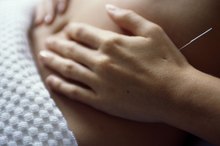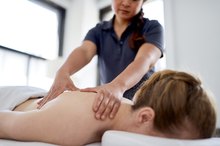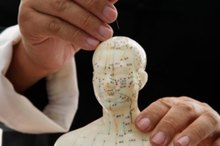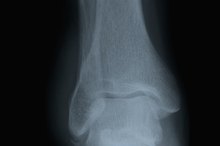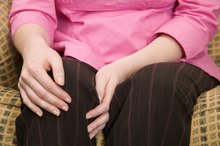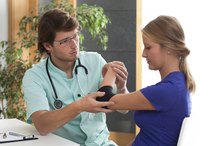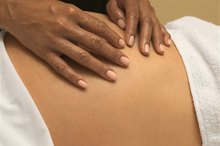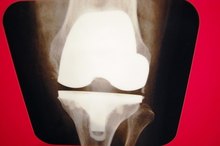Acupuncture and Inner Meniscus Tear
Acupuncture is a therapy that involves inserting thin needles into specific points on the body to elicit a specific reaction. Although a variety of acupuncture styles exist, much of the acupuncture used in the United States is based on traditional Chinese medicine theory. Treating a meniscus tear would involve diagnosing the problem using TCM theory and then placing the needles in the proper points. If you choose to use acupuncture, consult with your doctor to ensure there are no conflicts with any other forms of treatment you are receiving.
Meniscus Tear
The meniscus is a C-shaped structure made of cartilage that is located in the knee. It protects the knee by providing shock absorption and helps lubricate the knee for smoother movement. A tear in the inner, or medial, meniscus is a common occurrence in athletes who frequently twist the knee or over-flex it. Damage to the meniscus can cause a variety of symptoms, including pain, swelling, limited movement and a clicking or grinding noises. Treatment primarily consists of reducing pain and letting the tear heal, although surgery might be performed if the tear is severe enough.
- The meniscus is a C-shaped structure made of cartilage that is located in the knee.
- Treatment primarily consists of reducing pain and letting the tear heal, although surgery might be performed if the tear is severe enough.
Traditional Chinese Medicine and a Meniscus Tear
Does Acupuncture Help Fatty Liver Disease?
Learn More
The basic diagnosis for a meniscus tear, according to TCM theory, is trauma with local qi and blood stagnation. Qi is a complicated concept but basically translates to a subtle flow of energy that moves through the body while blood stagnation is comparable to a similar diagnosis in modern medicine. The acupuncture treatment for a meniscus tear would focus on moving qi and blood to decrease pain, reduce swelling and promote healing. Additional points would also be added to address any other issues that pertain to you as individual, such as a overall deficiency in the quality of the joints or cartilage.
- The basic diagnosis for a meniscus tear, according to TCM theory, is trauma with local qi and blood stagnation.
Acupuncture Points
The main acupuncture points prescribed would be located around the knee, with the exact location depending on the level of pain and swelling. In many cases, the points prescribed are on a specific line that runs along the body known as a meridian, but points that are painful, tight or tender — known as ashi points — are also commonly used. Distal points, or points farther from the knee, are also prescribed, depending on the full diagnosis. Points that are commonly used include points on the liver, kidney and spleen meridians because they are intimately associated with the joints, blood and bodily fluids.
- The main acupuncture points prescribed would be located around the knee, with the exact location depending on the level of pain and swelling.
- In many cases, the points prescribed are on a specific line that runs along the body known as a meridian, but points that are painful, tight or tender — known as ashi points — are also commonly used.
Recommendations
How Chinese Massage Might Help With Muscle and Joint Pain
Learn More
Consult your doctor before beginning any type of acupuncture treatment. If you choose acupuncture treatment, visit a fully trained, licensed acupuncturist. A qualified acupuncturist might also use other modalities of treatment, such as moxibustion, cupping and massage to treat your injury. If you do have surgery for your meniscus tear, acupuncture is helpful for the recovery process and postoperative pain, according to the World Health Organization.
- Consult your doctor before beginning any type of acupuncture treatment.
- If you do have surgery for your meniscus tear, acupuncture is helpful for the recovery process and postoperative pain, according to the World Health Organization.
Related Articles
References
- SportsInjuryClinic.net: Medial Cartilage Meniscus Injury
- Chinese Acupuncture and Moxibustion; Chen Xinnong, et. al.
- World Health Organization: Diseases and Disorders That Can Be Treated with Acupuncture
- Miller MD, Thompson SR. DeLee, Drez, & Miller’s Orthopaedic Sports Medicine: Principles and Practice (5th Edition). Elsevier. 2020.
- Meniscal Tears. USF Department of Orthopaedics & Sports Medicine USF Health. 2010.
- Meniscus Tears. American Academy Of Orthopaedic Surgeons.
- Meniscus Tears. Hospital for Special Surgery.
- Meniscus Tears. TeensHealth from Nemours. 2014.
- Masini BD, Dickens JF, Tucker CJ et al. Epidemiology of Isolated Meniscus Tears in Young Athletes. The Orthopaedic Journal of Sports Medicine. 2015;3(7).
- Howell R, Kumar NS, Patel N, Tom J. Degenerative meniscus: Pathogenesis, diagnosis, and treatment options. World J Orthop. 2014;5(5):597-602. doi:10.5312/wjo.v5.i5.597
- Torn Meniscus. UW Orthopaedics and Sports Medicine.
- Rinonapoli G, Carraro A, Delcogliano A. The clinical diagnosis of meniscal tear is not easy. Reliability of two clinical meniscal tests and magnetic resonance imaging. Int J Immunopathol Pharmacol. 2011;24(1 Suppl 2):39-44. doi:10.1177/03946320110241S208
- Meniscus tears - aftercare. US National Library of Medicine. 2019.
- Wolf SF. ACL Injuries in Young Athletes. American Academy of Pediatrics. 2019.
- Common knee injuries. American Academy Of Orthopaedic Surgeons.
- Hazle C, Duby C. Anterior cruciate ligament injury diagnosis and management in a pediatric patient: a case report. Int J Sports Phys Ther. 2012;7(6):678-90.
- 4 Injections That Could Ease Your Joint Pain. Cleveland Clinic. 2018.
- Kise NJ, Risberg MA, Stensrud S, Ranstam J, Engebretsen L, Roos EM. Exercise therapy versus arthroscopic partial meniscectomy for degenerative meniscal tear in middle aged patients: randomised controlled trial with two year follow-up. BMJ. 2016;354:i3740. doi:10.1136/bmj.i3740
- Miller MD, Thompson SR. DeLee, Drez, & Miller’s Orthopaedic Sports Medicine: Principles and Practice (5th Edition). Elsevier. 2020.
- Kim SG, Nagao M, Kamata K, Maeda K, Nozawa M. Return to sport after arthroscopic meniscectomy on stable knees. BMC Sports Sci Med Rehabil. 2013;5(1):23. doi:10.1186/2052-1847-5-23
- Cavanaugh JT, Killian SE. Rehabilitation following meniscal repair. Curr Rev Musculoskelet Med. 2012;5(1):46-58. doi:10.1007/s12178-011-9110-y
- Meniscus transplant. University of Iowa Hospitals & Clinics. 2018.
- Patil SS, Shekhar A, Tapasvi SR. Meniscal Preservation is Important for the Knee Joint. Indian J Orthop. 2017;51(5):576-587. doi:10.4103/ortho.IJOrtho_247_17
- Gersing AS, Schwaiger BJ, Nevitt MC, et al. Is Weight Loss Associated with Less Progression of Changes in Knee Articular Cartilage among Obese and Overweight Patients as Assessed with MR Imaging over 48 Months? Data from the Osteoarthritis Initiative. Radiology. 2017;284(2):508-520. doi:10.1148/radiol.2017161005
- Maher SA, Rodeo SA, Warren RF. The Meniscus. J Am Acad Orthop Surg. 2017 Jan;25(1):e18-e19. doi: 10.5435/JAAOS-D-16-00689
- American Academy of Orthopedic Surgeons. (n.d.). Meniscus Tears.
- Jones BQ, Covey CJ, Sineath MH. Nonsurgical Management of Knee Pain in Adults. Am Fam Physician. 2015 Nov 15;92(10):875-83.
- Kise NJ, Risberg MA, Stensrud S, Ranstam J, Engebretsen L, Roos EM. Exercise therapy versus arthroscopic partial meniscectomy for degenerative meniscal tear in middle aged patients: randomised controlled trial with two year follow-up. BMJ. 2016 Jul 20;354:j3740. doi: 10.1136/bmj.i3740
- Raj MA, Bubnis MA.StatPearls [Internet]. Knee Meniscal Tears. Treasure Island (FL): StatPearls Publishing; 2018 Jan-.
Writer Bio
Solomon Branch specializes in nutrition, health, acupuncture, herbal medicine and integrative medicine. He has a B.A. in English from George Mason University, as well as a master's degree in traditional Chinese medicine.
